UK's first domestic grid connected PV system
Following installation of its solar photovoltaic array at ‘The Autonomous House’ in Southwell, Nottinghamshire, the first electricity from a private solar system was generated to the UK grid on 27th July 1994. This was a major achievement for Wind & Sun and the birth of a whole solar energy sector and demonstrated the feasibility and potential of harnessing the power of the sun. Solar panels on roofs have since become a common sight around the country. A whole industry has grown up to service them, with installers in almost every town, reduced costs and attractive with payback times.
Background
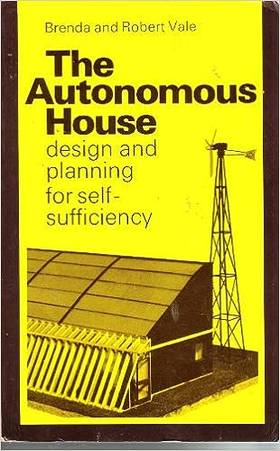
In 1975 architects Brenda and Robert Vale published 'The Autonomous House', a manifesto offering down-to-earth suggestions for building homes that do not pollute the earth or squander its resources. Their book received tremendous praise around the world and was seen as a significant move toward green architecture.
While Steve Wade was studying Physics at Oxford University he came across this book and it helped inspire him to start Wind & Sun in 1984.
In the early 1990s, the Vales decided to turn their groundbreaking ideas into reality and build a house on the principles of sustainable resources near the centre of the small town of Southwell, Nottinghamshire. As specialists in green architecture, the Vales sought to create an environmentally friendly four-bedroom house that was neither exotic in appearance nor difficult to maintain. Originally, the intention was to have no connection to mains water, sewage or electricity and so be completely autonomous.
Wind & Sun were approached to help design and supply an off-grid battery based system to provide the electricity - at the time nobody in their right mind would consider using solar to power a house in the cloudy UK - but Steve had read Brenda & Roberts' book and knew they were serious!
Wind & Sun were at first approached to supply an off-grid system using battery storage to power the house. However, providing reliable power throughout the year would have been difficult and expensive to achieve.
At the time grid connected PV was being developed in Germany as part of their ‘1000 roofs programme'. Steve had met SMA at a trade fair in Amsterdam where they were exhibiting ‘grid connected PV inverters’. He suggested to the Vales trying this for their house using a PV system sized to generate the equivalent of their annual electricity requirement and using the grid as virtual storage.
SMA agreed to supply Wind & Sun and the local grid company (EMEB) were approached. They were supportive of the idea and agreed that if the inverter was good enough for Germany it was probably good enough for the UK and allowed the connection.
The PV system used a 2.16kWp array sited on a south facing oak frame garden pergola comprising 36x Solarex 60Wp polycrystalline modules and a SMA PV WR-1800 inverter – the first SMA inverter installed in the UK.


The Autonomous House
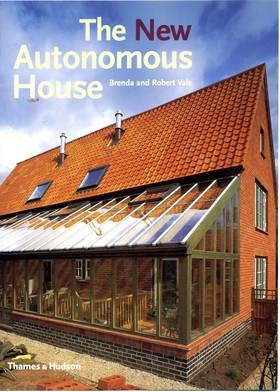
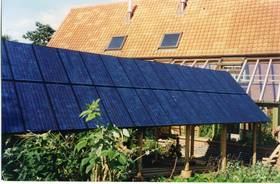
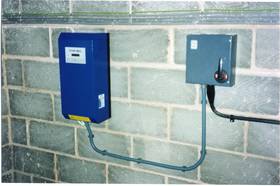
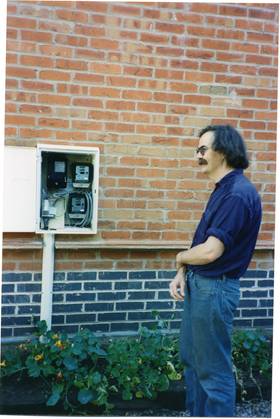
The building of this house is described in their book 'The New Autonomous House' .
The house is self sufficient in energy and water:
- The construction forms a highly insulated solid mass to eliminate heating needs by giving long term heat storage.
- A two storey conservatory provides passive solar heating
- Water is collected from the roof and filtered for drinking.
- Sewage is composted
- Electricity is generated by a 2.16kWp PV array.
Due to the orientation of the house the PV array was designed to be mounted on a free-standing pergola in the garden. The 2.16kWp Photovoltaic Array is made up of 36 Solarex MSX-60 60Wp modules connected in series strings of 6 modules. Output was fed to an SMA PV WR-1800 1.8kVA inverter and then to the house consumer unit. Generated power is first supplied to the house loads and any surplus exported to the grid.
At night or when power requirements exceed power being produced, electricity is imported as normal from the local DNO, Powergen. Metering is performed by two standard mechanical meters.
PV system design supply and installation was carried out by Wind & Sun. Careful planning meant installation took only two days and commisioning was immediate.
The cost of the house including the PV system was just under £155,000, - typical at the time for a house of this size & quality. The extra costs of technical features used in the house is compensated for by savings elsewhere, eg. no fitted kitchen, showing that environmentally responsible building and living needn't cost the earth.
The PV system whose installed cost was ~ £6900/kWp with a module cost price of ~ £4.40/Wp. This equated to a 200 year payback time!
Robert Vale said at the time: “ with an initial cost of ~ £15,000 and an output of approximately 1800kWh per annum it does not ‘pay’ for itself in a commercial sense”, however, it was installed not for income generation but as part of an environmentally friendly building.
Since installation The Autonomous House’s solar panels have generated over 33MWh of electricity (enough to make a million cups of tea!), converting daylight into electrical power.








UK’s First Domestic Grid Connected PV System – 20 Years On

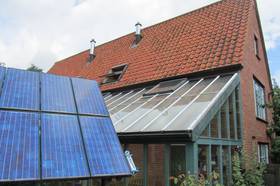

The original inverter was replaced in 2009 with a more modern version (Sunny Boy SB-2500), but with this exception the system has worked faultlessly for over 20 years.
On the 20th anniversary Wind & Sun re-visited the system to test performance.
The system was tested using a Solmetric PV Analyzer. This measures solar irradiance and back of cell temperature whilst performing a full I-V curve test from open-circuit voltage to short circuit current. From this a comparison in performance can be made against the original panel flash test data when it left the factory.
According to the manufacturer’s warranty, at this point in their life the panels should be putting out 80% of their initial value.
We were astounded to find the first panel tested producing up to almost 95% of it’s original rated power!
Even the entire array, tested as a whole with some inevitable dirt accumulation, panel mis-matching and some slight localised shading (from an unpruned apple tree) scored almost exactly 80%!






Update 2023
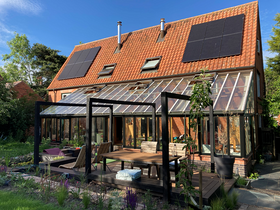

The original pergola and PV array have been dismantled and re-purposed elsewhere. The new owners of the house moved them because they dominated (and shaded) the garden and they wanted to grow more food, and obviously it is now easier to put PV on roofs. A new 4kWp PV array has been installed on the house roof although this achieves less due to orientation (west facing at 55°). It was installed as part of a community effort, one of around ten local homes to install solar PV in spring 2020.
More importantly, a second site was found for the original panels, and they are in active retirement at a city farm in Leeds, on a handcrafted hub for a community market garden. See: Meanwood Valley Urban Farm



